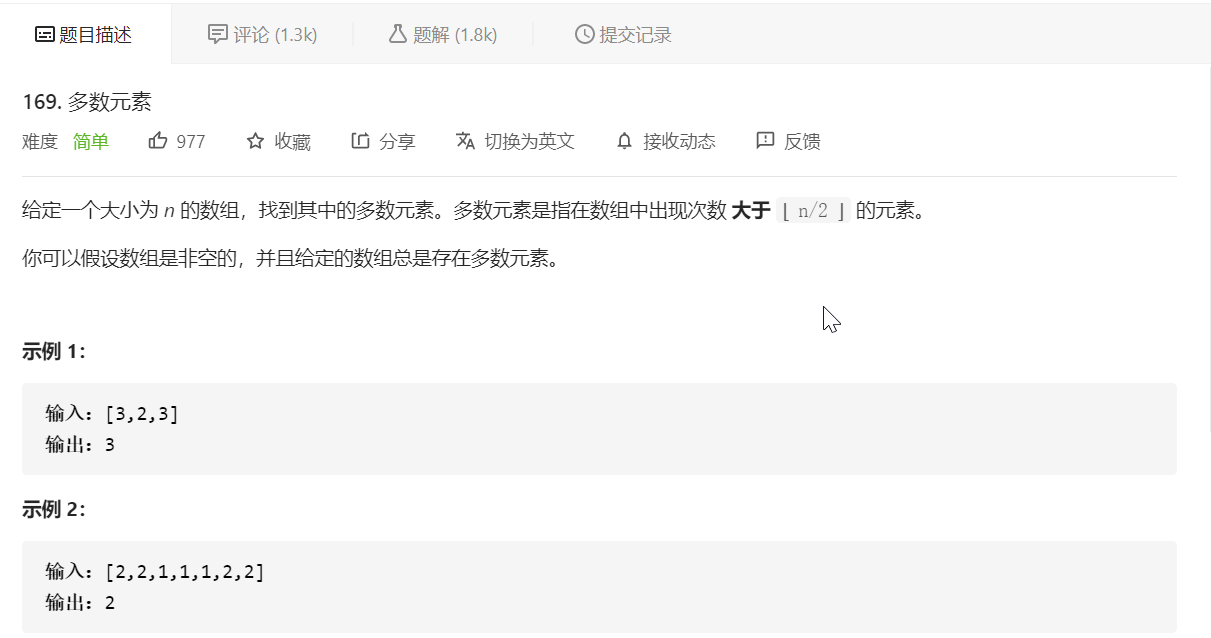题目描述:

解题思路:
可以使用HashMap
- 对于数组中的每一个元素,依次加入到HashMap中去
- 在每次加入前,检查该map中是否含有此关键字
- 如果没有则将该值设为1
- 如果已经存在该关键字,则get(key)+1
- 然后循环遍历给map,记录key的value最大值的那个entry,然后返回该key
- 由于HashMap的查找和存储只需要常数的时间,因此该方法的时间复杂度是O(n),期间使用了HashMap,开辟了一个O(n)的空间。
可以将该数组进行排序,排序完成之后,由于有至少n/2的数字才称之为该众数,因此无论奇偶,索引值为n/2的这个值,即是众数。
- 排序需要的时间复杂度是O(nlogn)
- 空间复杂度,使用了java自带的排序算法,需要O(log n)的栈空间
分治法
如果数a是数组nums的众数,现在将nums分成两部分,那么a至少是其中一部分的众数。
- 因此,将数组分成左右两部分,分别求出左半部分的众数al,和右半部分的众数ar;
- 然后在al和ar中选取正确的众数
摩尔投票法
如果把众数即为+1;把其他数记为-1;显然和大于0
- 我们维护一个候选众数candidate和它出现的次数count。初始时,candidate可以为任意的数,count为0
- 遍历数组中的所有元素,对于每个元素x进行判断,在判断和candidate之前,先判断此时的count是否为0;
- 如果为0,说明candidate需要更换了
- 此时需要将x的值赋值给candidate
- 判断x;
- 如果x与candidate相等,count++
- 反之,count--
- 时间复杂度O(n);空间复杂度O(1)
代码:
//哈希表
class Solution {
public int majorityElement(int[] nums) {
HashMap<Integer,Integer> map = new HashMap<>();
int count = 0;
for(int i = 0;i < nums.length;i++){
if(!map.containsKey(nums[i])){
map.put(nums[i],1);
}else{
map.put(nums[i],map.get(nums[i])+1);
}
}
Map.Entry<Integer,Integer> majorityEntry = null;
for(Map.Entry<Integer,Integer> entry : map.entrySet()){
if(majorityEntry == null || entry.getValue() > majorityEntry.getValue() ){
majorityEntry = entry;
}
}
return majorityEntry.getKey();
}
}
//排序
class Solution {
public int majorityElement(int[] nums) {
int len = nums.length;
Arrays.sort(nums);
return nums[len/2];
}
}
//分治
class Solution {
public int countMajority(int left,int right,int[] nums,int key){
int count = 0;
for(int i = left;i <= right;i++){
if(nums[i] == key){
count++;
}
}
return count;
}
public int divide(int left,int right,int[] nums){
if(left == right){
return nums[left];
}
int mid = (left + right) >> 1;
//int mid = (right-left) / 2 + left;
int al = divide(left,mid,nums);
int ar = divide(mid+1,right,nums);
if(al == ar){
return al;
}
int leftCount = countMajority(left,right,nums,al);
int rightCount = countMajority(left,right,nums,ar);
return leftCount > rightCount ? al : ar;
}
public int majorityElement(int[] nums) {
return divide(0,nums.length-1,nums);
}
}
//摩尔投票法
class Solution {
public int majorityElement(int[] nums) {
int count = 0;
int majority = nums[0];
for(int i = 0;i < nums.length;i++){
if(count == 0){
majority = nums[i];
count++;
}else{
if(majority == nums[i]){
count++;
}else{
count--;
}
}
}
return majority;
}
}
原文:https://www.cnblogs.com/forrestyu/p/14758067.html